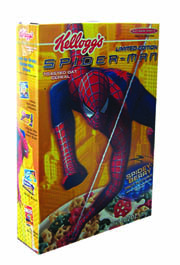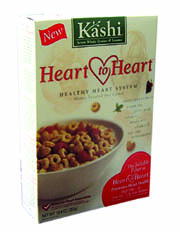
In its report on the U.S. breakfast cereal market, Mintel International Group (Chicago) finds a category with increasing competition and a consumer base abandoning breakfast entirely. With those notable hurdles, the market for breakfast cereal has managed to post growth over the past several years, albeit slow. In current dollars, sales grew from $8.5 billion in 1998 to $9 billion in 2003, representing a 1% annual increase.
Cereal faces competition on several fronts: competing convenient breakfast alternatives, a large (and perhaps growing) number of consumers opting to skip the morning meal, and little growth in the population of children and teenagers. In the midst of these challenges, however, manufacturers have managed to maintain, indeed improve upon, dollar sales. Promotions tied to television shows or movies have boosted the interest of younger people, while technological advancements have inserted real fruit into cereal to attract adults as well as youngsters. Nevertheless, Mintel does draw one conclusion likely to concern cereal manufacturers: “Nearly all households eat cereal, and do not appear to be increasing consumption.”
Leading the way in the cereal segment are four companies: Kellogg (Battle Creek, Mich.) and its market-leading 29.2% share, followed by the 27.4% held by General Mills (Minneapolis), PepsiCo's (Purchase, N.Y.) Quaker Oats' (Chicago) 13.8% and the 12.8% share of the Post division of Kraft (Glenview, Ill.). The acquisition of Pillsbury led General Mills to divert some efforts from its cereal development, or the company might have been the category leader, a spot it held as recently as 1999.
Acquisition served as PepsiCo's route into the cereal market, with its purchase of Quaker Oats. However, PepsiCo clearly longed for Quaker's Gatorade sports drinks. Mintel speculates on several occasions about the possible sale of Quaker's strong cereal brands. As Mintel notes, these brands may be highly prized, but to maintain their status among the market leaders, they will require strong investment.
That being said, it is important to note that Quaker has innovated to maintain its dominance of the admittedly slim hot cereal market. For that matter, the next-leading “brand” in the segment is private label. Cementing its place atop the oatmeal brands, Quaker's innovative efforts have included such kid-friendly introductions as Dinosaur Eggs and Treasure Hunt, which contain eggs or treasure chests that dissolve to reveal surprises. Both exemplify the need to connect with children's sense of play and, according to Mintel, “give them a reason to want it rather than some other cereal or convenient breakfast food.”
However, children have not been Quaker's sole focus. Its Instant Express is an effort to make oatmeal more convenient, and Nutrition for Women has a precise target and has managed to grow sales.

Getting Hotter
This is not to say that Quaker is without competition in the hot cereal category, but others have failed to innovate. Cases in point are Kraft's Cream of Wheat, Cream of Rice and Malt-O-Meal hot cereal. All are packaged and presented rather plainly, have little marketing support and hold a small and deteriorating share of the hot cereal market. As a consequence, the limited shelf space for hot cereal products typically is shared between Quaker and private label options.The true benefit to the hot cereal category has been on the health front. Sales increased much faster than those of cold cereal between 1998 and 2003, which Mintel attributes largely to the explicit heart-health claims for whole oats that manufacturers have been allowed to make since January 1997. The FDA says that 3g per day of beta-glucan can be effective in reducing cholesterol levels, and manufacturers of whole oat products are allowed to state such claims as “Soluble fiber from foods such as oats, as part of a diet low in saturated fat and cholesterol, may reduce the risk of heart disease.” Touting such health benefits could boost already-high consumption levels among older adults, and government efforts to reduce obesity also may work in hot cereal's favor over the coming several years.
Nonetheless, hot cereal boasts none of the convenient advantages even of its cold counterparts. Yogurt tubes and breakfast bars, which epitomize convenience, serve as the morning meal of choice for many on the go. Furthermore, while hot cereal is consumed in roughly two-thirds of households, consumption levels drop dramatically between the ages of eight and 12. Despite some efforts to make hot cereal a quicker meal (placing it in single-serve containers that require only the addition of hot water), Mintel believes the industry would be well served to apply the same innovations and marketing support as enjoyed by cold cereal products.
Such Characters
One of the most successful marketing efforts for cold cereals has been to relate the product to established spokescharacters such as Tony the Tiger or the Snap, Crackle and Pop characters, or such movie and television stalwarts as Disney (Orlando, Fla.) icons, Marvel (New York) superheroes Spider-Man and Hulk, or DreamWorks' (Glendale, Calif.) Shrek. While not a new phenomenon (licensing dates back to 1930s' appearances by Buck Rogers on Kellogg's cereals), tie-ins are increasing in number and sophistication, believes Mintel. Kellogg's January 2002 introduction of products based on well-known Disney characters Mickey Mouse and Winnie the Pooh resulted in strong sales for the company. Around the same time, the company added a cereal based on Buzz Lightyear from Toy Story fame, which has since been replaced with a cereal boasting characters from The Lion King. Kraft got into the act for cereals based on the Spider-Man and Hulk films, but may not have enjoyed quite the level of success as Kellogg's, which this year boasts a cereal tie-in to the second installment of the Spider-Man film franchise.Mintel believes the drawing power of entertainment-themed cereals may last only one to two years. For example, products linked to Mickey Mouse and Winnie the Pooh tallied more than $20 million in their first 52 weeks, yet each dropped by nearly $10 million the following year. Indeed, using established entertainment characters may prove inferior to company spokescharacters. Note Kellogg's 2003 introduction of a cinnamon cereal to appeal to children: the company used Tony the Tiger and named the new product Tony's Cinnamon Krunchers, garnered in excess of $20 million in first-year sales and may have strengthened the product's long-term potential by tying it to an established company icon.
Technological innovation has coupled with licensing in recent years to offer cereal manufacturers new options. New technology has allowed short runs of themed cereal to be cost-effective, notes Mintel. For example, Kraft's Hulk-themed, limited edition green cereal (under the Post banner) featured marshmallows shaped and colored like bricks, beakers, explosions and Hulks.
For that matter, to fend off the private label competition so pronounced in other categories, cereal manufacturers have staved off their price-conscious counterparts through innovation--be it changing shapes, colors or flavors--and endorsements. All of which leads to private label offerings registering only 9.7% of the market, a marginal increase between 2001 and 2003. Private label manufacturers, however, do seem to realize their core strengths; the most successful mimic staple cereals that have little innovation, such as raisin bran and cinnamon crunch.
Regarded as one of the first “health” foods, cereals fortified with vitamins and minerals were a forerunner of modern functional foods, says Mintel. Indeed, nutrient levels still play a significant role in the cereal decisions for consumers over the age of 45. Fiber, fat and cholesterol are of substantial concern to older consumers, who also watch sugar content (due to the higher incidence of diabetes in older adults).
Helping to improve the perceived healthfulness of a number of new products has been new technology that improved the performance of freeze-dried fruit (there were quite a number of introductions between 2001 and 2003). Improved packaging to combat moisture resulted in successful launches such as Special K Red Berries (Kellogg's), Berry Bust Cheerios, and Honey Bunches of Oats With (the latter two from General Mills).

A Matter of Health?
Consumers' regard of certain cereals as “healthy” could be called into question, considering the rather substantial sugar levels of some products. Kashi Go Lean Crunch (from Kellogg's) boasts 25.0%, with Post Fruit & Fiber claiming 29.1%. Mintel categorizes these two products as “moderate-sugar cereals” and cautions that consumers simply may be confused as to their sugar content, “with health-conscious consumers assuming they are low in sugar.” However, Mintel's exclusive consumer research explored a range of consumer behaviors and opinions, and revealed 59% of adults ranked sugar second-highest among their concerns when buying cereal. The other items mentioned were fiber, fat, carbohydrates, protein, vitamins and cholesterol.Women expressed the most concern about the amount of fat and sugar in cereal, while men registered slightly more interest in vitamins. The other listed factors, however, were of similar importance to men and women, leading Mintel to speculate that nutritional content is a draw for a large portion of men and women.
Products focused upon the female consumer are fairly easy to find, as they are a little more likely than men to eat cereal. However, Mintel argues in favor of products specifically targeting men, “both in the transition years beyond 17 and for those in the swelling population of ages 45+.” Currently, the likelihood of consuming cereal declines after age 17 and much more sharply for men than women.
Of course, the consumption of breakfast at all seems to be declining dramatically. In Mintel's research, a quarter of adults eat no breakfast or do so once or twice a week, and another quarter claim to eat breakfast about half of the time, suggesting a large number of missed breakfast opportunities per week. Overall, 76% of adults eat cereal, and the Simmons National Consumer Survey (New York) finds 89% of teens and 98% of children do as well. The latter results are unsurprising, considering the focus manufacturers place upon attracting young people--be it through licensing, innovation or the abundance of marketing efforts.
Unfortunately, this saturation of one of the strongest consumer bases may not be the best of news. Between 2004 and 2008, the number of children will not grow by much. The number of 6- to 11-year-olds who eat cereal will decrease by 371,000, with just a 412,000 growth in those aged 12 to 17. By 2008, only 30% of households will have children under the age of 18, further evidence of the industry's need to cater to the rapidly growing number of older adults.
The future of the market does have promise. Expect increased investment from Kellogg and General Mills, particularly now that the latter has almost completed its integration of Pillsbury. To remain among the major players in the category, Quaker and Post will have to be more aggressive, Mintel believes. However, it is among consumers where the focus must rest.
Cereal has a healthful image among consumers, and manufacturers could benefit from this perception, particularly in the ongoing battle with obesity. However, the future has its negative aspects as well. Time constraints continue to point consumers toward portable options, while the number of children will remain constant in the coming years. Add to this manufacturers' lack of pricing power, which is explained in detail in Mintel's report, and the category is poised for a growth of only 1% to nearly $9 billion throughout 2004 and 2008.
